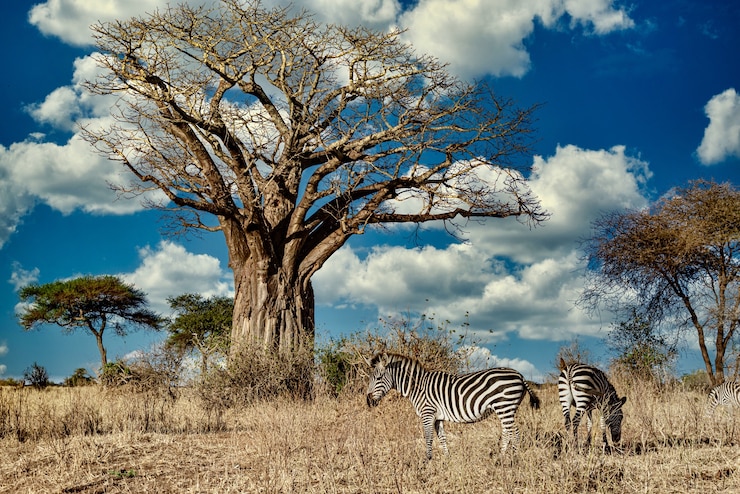Follow the incredible journey of over two million wildebeest, zebras, and gazelles as they traverse the Serengeti-Mara ecosystem in search of fresh grazing.
# The Great Migration: Nature's Greatest Spectacle
The Great Migration is one of the most awe-inspiring natural phenomena on Earth. Every year, over two million wildebeest, accompanied by hundreds of thousands of zebras and gazelles, embark on a circular journey through the Serengeti-Mara ecosystem, following ancient pathways in search of fresh grazing and water.
## Understanding the Migration
### The Participants
The Great Migration involves several species, each playing a crucial role in this natural spectacle:
**Wildebeest (1.5 million)**:
- The main participants in the migration
- Follow a predictable annual cycle
- Highly social animals that move in massive herds
**Plains Zebras (200,000)**:
- Often lead the migration
- Excellent at finding water sources
- Their grazing creates shorter grass preferred by wildebeest
**Thomson's Gazelles (300,000)**:
- Follow behind the main herds
- Prefer the shortest grass
- More agile and can escape predators more easily
### The Ecosystem
The migration takes place across the greater Serengeti-Mara ecosystem, spanning:
- **Serengeti National Park (Tanzania)**: 14,750 km²
- **Maasai Mara National Reserve (Kenya)**: 1,510 km²
- **Ngorongoro Conservation Area (Tanzania)**: 8,292 km²
- **Various conservancies and game reserves**
## The Annual Cycle
### January - March: Calving Season (Southern Serengeti)
**Location**: Ndutu area and southern Serengeti plains
**Highlights**:
- Over 400,000 calves born in a 2-3 week period
- Abundant predator activity
- Lush green grass from short rains
- Excellent wildlife photography opportunities
**Why Here**: The short grass plains provide nutritious grazing for pregnant and nursing mothers, while the open terrain allows for early predator detection.
### April - May: The Journey Begins (Central Serengeti)
**Location**: Central Serengeti moving towards Western Corridor
**Highlights**:
- Long rains begin, triggering movement
- Herds start forming larger groups
- River crossings at Grumeti River
- Dramatic weather and landscapes
**Challenges**: Heavy rains can make roads impassable, but the landscape is at its most beautiful.
### June - July: Western Corridor Crossings
**Location**: Western Serengeti and Grumeti River area
**Highlights**:
- First major river crossings
- Crocodile encounters at river crossings
- Massive herds gathering
- Excellent predator viewing
**The Grumeti River**: Though smaller than the Mara River, these crossings are equally dramatic and often less crowded with tourists.
### August - October: The Mara River Crossings
**Location**: Northern Serengeti and Maasai Mara
**Highlights**:
- The most famous river crossings
- Peak tourist season
- Highest concentration of wildlife
- Dramatic predator-prey interactions
**The Mara River**: The most challenging obstacle, with strong currents, steep banks, and large crocodiles waiting for the crossing herds.
### November - December: The Return Journey
**Location**: Eastern Serengeti
**Highlights**:
- Return journey to southern plains
- Short rains begin
- Mating season begins
- Fewer tourists, better prices
## The Science Behind the Migration
### Navigation and Timing
The migration is driven by several factors:
**Rainfall Patterns**: Animals follow the rains, which determine grass growth
**Genetic Programming**: Ancient instincts guide the timing and routes
**Magnetic Fields**: Some research suggests animals may use Earth's magnetic field for navigation
**Social Learning**: Young animals learn routes from experienced adults
### Ecological Benefits
The migration provides crucial ecological services:
**Nutrient Distribution**: Animal waste fertilizes different areas throughout the year
**Grass Management**: Grazing prevents overgrazing in any single area
**Predator Support**: Supports large populations of predators
**Seed Dispersal**: Animals transport seeds across vast distances
## Predators and the Migration
### The Big Cats
**Lions**: Follow the herds, with prides timing births to coincide with abundant prey
**Leopards**: More solitary but benefit from increased prey availability
**Cheetahs**: Particularly active during calving season when young animals are vulnerable
### Other Predators
**Spotted Hyenas**: Highly efficient scavengers and hunters
**Wild Dogs**: Pack hunters that can take down adult wildebeest
**Crocodiles**: Nile crocodiles in rivers take advantage of crossings
### Scavengers
**Vultures**: Multiple species clean up carcasses
**Jackals**: Opportunistic feeders following the herds
**Marabou Storks**: Large scavenging birds
## River Crossings: The Ultimate Drama
### The Mara River
The most famous and dramatic crossings occur at the Mara River:
**Crossing Points**: Several traditional crossing points used year after year
**Timing**: Unpredictable - herds may wait days before crossing
**Dangers**: Strong currents, steep banks, crocodiles, and trampling
**Survival Strategy**: Safety in numbers - mass crossings reduce individual risk
### Factors Affecting Crossings
- **Water levels**: Too high or low can delay crossings
- **Weather**: Rain and storms can trigger or delay crossings
- **Predator presence**: Lions on the far bank may deter crossing
- **Herd dynamics**: It only takes one brave individual to start a crossing
## Best Viewing Locations and Times
### Tanzania (Serengeti)
**Calving Season (Jan-Mar)**:
- Ndutu area
- Southern Serengeti plains
- Mobile camps follow the herds
**River Crossings (Jun-Jul)**:
- Grumeti River area
- Western Corridor
- Less crowded than Mara crossings
### Kenya (Maasai Mara)
**Peak Season (Aug-Oct)**:
- Mara River crossings
- Northern Mara conservancies
- Highest wildlife concentrations
**Best Crossing Points**:
- Paradise Crossing
- Lookout Hill Crossing
- Serena Crossing
## Photography Tips
### Equipment Recommendations
**Camera Bodies**: Fast autofocus for action shots
**Lenses**:
- 70-200mm f/2.8 for medium distance
- 100-400mm or 150-600mm for distant action
- 24-70mm for landscape and environmental shots
### Shooting Techniques
**River Crossings**:
- Use fast shutter speeds (1/1000s or faster)
- Continuous autofocus mode
- Burst mode for action sequences
- Position yourself downstream for better angles
**Calving Season**:
- Focus on interactions between mothers and calves
- Capture predator-prey dynamics
- Use longer lenses to avoid disturbing animals
### Composition Tips
- Include environmental context
- Capture the scale of the herds
- Focus on individual stories within the mass
- Use dust and dramatic skies to enhance mood
## Conservation Challenges
### Threats to the Migration
**Habitat Loss**: Agricultural expansion and human settlement
**Climate Change**: Changing rainfall patterns affect grass growth
**Poaching**: Illegal hunting reduces animal numbers
**Infrastructure Development**: Roads and fences can block migration routes
### Conservation Efforts
**Protected Areas**: National parks and reserves protect critical habitat
**Community Conservancies**: Local communities benefit from wildlife conservation
**Anti-Poaching**: Ranger patrols and technology combat illegal hunting
**Research**: Scientific studies inform conservation strategies
## Planning Your Migration Safari
### Timing Your Visit
**For Calving**: January-March in southern Serengeti
**For River Crossings**: July-October in northern Serengeti/Mara
**For Fewer Crowds**: April-June or November-December
**For Best Weather**: June-October (dry season)
### Accommodation Options
**Luxury Lodges**: Permanent lodges with excellent service
**Mobile Camps**: Follow the migration for optimal positioning
**Tented Camps**: Good balance of comfort and authenticity
**Budget Camping**: More affordable options available
### What to Expect
- **Early Morning Game Drives**: Best wildlife activity
- **Long Days**: Full day drives during peak migration
- **Dusty Conditions**: Especially during dry season
- **Unpredictable Wildlife**: Migration timing can vary
- **Incredible Memories**: Life-changing experiences
## Cultural Significance
### Local Communities
The migration has cultural significance for local communities:
- **Maasai**: Traditional grazing patterns follow similar routes
- **Cultural Ceremonies**: Some rituals timed with animal movements
- **Traditional Knowledge**: Local guides have generational knowledge
- **Economic Benefits**: Tourism provides important income
### Global Importance
The Great Migration is:
- **UNESCO World Heritage Site**: Recognized global importance
- **Natural Wonder**: One of the "Seven Natural Wonders of Africa"
- **Scientific Value**: Important for ecological research
- **Tourism Icon**: Attracts visitors from around the world
## Conclusion
The Great Migration represents the raw power and beauty of nature at its most spectacular. This ancient journey, repeated for millennia, connects us to the fundamental rhythms of life on Earth. Witnessing the migration is more than just a safari experience - it's a profound encounter with one of nature's greatest phenomena.
Whether you're watching hundreds of thousands of wildebeest thundering across the plains, witnessing the drama of a river crossing, or observing the tender moments between mothers and newborn calves, the Great Migration offers experiences that will stay with you forever.
As we face increasing environmental challenges, the Great Migration reminds us of the importance of protecting these natural systems. The survival of this incredible spectacle depends on our continued commitment to conservation, community involvement, and sustainable tourism practices.
Plan your visit to witness this natural wonder, but remember that you're not just a spectator - you're part of the story of conservation that will determine whether future generations can experience the magic of the Great Migration.

